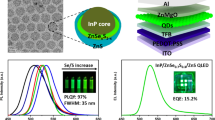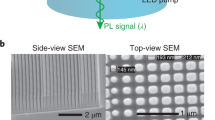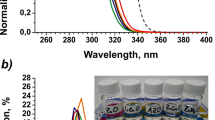Abstract
Indium gallium nitride (InGaN)-based micro-LEDs (μLEDs) are suitable for meeting ever-increasing demands for high-performance displays owing to their high efficiency, brightness and stability1,2,3,4,5. However, μLEDs have a large problem in that the external quantum efficiency (EQE) decreases with the size reduction6,7,8,9. Here we demonstrate a blue InGaN/GaN multiple quantum well (MQW) nanorod-LED (nLED) with high EQE. To overcome the size-dependent EQE reduction problem8,9, we studied the interaction between the GaN surface and the sidewall passivation layer through various analyses. Minimizing the point defects created during the passivation process is crucial to manufacturing high-performance nLEDs. Notably, the sol–gel method is advantageous for the passivation because SiO2 nanoparticles are adsorbed on the GaN surface, thereby minimizing its atomic interactions. The fabricated nLEDs showed an EQE of 20.2 ± 0.6%, the highest EQE value ever reported for the LED in the nanoscale. This work opens the way for manufacturing self-emissive nLED displays that can become an enabling technology for next-generation displays.
This is a preview of subscription content, access via your institution
Access options
Access Nature and 54 other Nature Portfolio journals
Get Nature+, our best-value online-access subscription
$29.99 / 30 days
cancel any time
Subscribe to this journal
Receive 51 print issues and online access
$199.00 per year
only $3.90 per issue
Buy this article
- Purchase on Springer Link
- Instant access to full article PDF
Prices may be subject to local taxes which are calculated during checkout




Similar content being viewed by others
Data availability
All data generated or analysed during this study are included in the paper.
Code availability
We used the commercially available software of Ansys Lumerical for the FDTD simulation and VASP for the DFT calculations. The simulation settings are presented in Methods. The atomic structure data for the defects are available at Zenodo, https://doi.org/10.5281/zenodo.6544988.
References
Lin, J. Y. & Jiang, H. X. Development of microLED. Appl. Phys. Lett. 116, 100502 (2020).
Wierer Jr., J. J. & Tansu, N. III-nitride micro-LEDs for efficient emissive displays. Laser Photonics Rev. 13, 1900141 (2019).
Virey, E. H. & Baron, N. 45-1: Status and prospects of microLED displays. SID Symp. Dig. Tech. Pap. 49, 593–596 (2018).
Templier, F. GaN‐based emissive microdisplays: a very promising technology for compact, ultra‐high brightness display systems. J. Soc. Inf. Display 24, 669–675 (2016).
Jiang, H. X. & Lin, J. Y. Nitride micro-LEDs and beyond—a decade progress review. Opt. Express 21, A475–A484 (2013).
Olivier, F. et al. Influence of size-reduction on the performances of GaN-based micro-LEDs for display application. J. Lumin. 191, 112–116 (2017).
Hwang, D. et al. Sustained high external quantum efficiency in ultrasmall blue III–nitride micro-LEDs. Appl. Phys. Express 10, 032101 (2017).
Konoplev, S. S., Bulashevich, K. A. & Karpov, S. Y. From large-size to micro-LEDs: scaling trends revealed by modeling. Phys. Status Solidi A 215, 1700508 (2018).
Smith, J. M. et al. Comparison of size-dependent characteristics of blue and green InGaN microLEDs down to 1 µm diameter. Appl. Phys. Lett. 116, 071102 (2020).
Schubert, E. F. Light-Emitting Diodes (Cambridge Univ. Press, 2006).
Ren, A. et al. Emerging light-emitting diodes for next-generation data communications. Nat. Electron. 4, 559–572 (2021).
Biwa, G. et al. Technologies for the Crystal LED display system. J. Soc. Inf. Display 29, 435–445 (2021).
Huang, Y. et al. Mini-LED, micro-LED and OLED displays: present status and future perspectives. Light Sci. Appl. 9, 105 (2020).
Kawanishi, H. et al. High-resolution and high-brightness full-colour “Silicon Display” for augmented and mixed reality. J. Soc. Inf. Display 29, 57–67 (2021).
Xiong, J. et al. Augmented reality and virtual reality displays: emerging technologies and future perspectives. Light Sci. Appl. 10, 216 (2021).
Liu, Z. et al. Micro-light-emitting diodes with quantum dots in display technology. Light Sci. Appl. 9, 83 (2020).
Zhang, L. et al. 31.1: Invited Paper: Monochromatic active matrix micro-LED micro-displays with >5,000 dpi pixel density fabricated using monolithic hybrid integration process. SID Symp. Dig. Tech. Pap. 49, 333–336 (2018).
Bulashevich, K. A. & Karpov, S. Y. Impact of surface recombination on efficiency of III-nitride light-emitting diodes. Phys. Status Solidi RRL 10, 480–484 (2016).
Sung, Y. G. Micro-led element for horizontally-aligned assembly, method for manufacturing same, and horizontally-aligned assembly comprising same. US patent US20170317228A1 (2017).
Park, H., Kim, B.-J. & Kim, J. Electroluminescence from InGaN/GaN multiquantum-wells nanorods light-emitting diodes positioned by non-uniform electric fields. Opt. Express 20, 25249–25254 (2012).
Park, H. et al. Horizontally assembled green InGaN nanorod LEDs: scalable polarized surface emitting LEDs using electric-field assisted assembly. Sci. Rep. 6, 28312 (2016).
Yang, C. et al. Enhancement in light extraction efficiency of GaN-based light-emitting diodes using double dielectric surface passivation. Opt. Photonics J. 2, 185–192 (2012).
Bai, J. et al. Ultrasmall, ultracompact and ultrahigh efficient InGaN micro light emitting diodes (μLEDs) with narrow spectral line width. ACS Nano 14, 6906–6911 (2020).
Wong, M. S. et al. High efficiency of III-nitride micro-light-emitting diodes by sidewall passivation using atomic layer deposition. Opt. Express 26, 21324–21331 (2018).
Wong, M. S. et al. Size-independent peak efficiency of III-nitride micro-light-emitting-diodes using chemical treatment and sidewall passivation. Appl. Phys. Express 12, 097004 (2019).
Ley, R. T. et al. Revealing the importance of light extraction efficiency in InGaN/GaN microLEDs via chemical treatment and dielectric passivation. Appl. Phys. Lett. 116, 251104 (2020).
Dubey, R., Rajesh, Y. & More, M. Synthesis and characterization of SiO2 nanoparticles via sol-gel method for industrial applications. Mater. Today Proc. 2, 3575–3579 (2015).
Azlina, H., Hasnidawani, J., Norita, H. & Surip, S. Synthesis of SiO2 nanostructures using sol-gel method. Acta Phys. Pol. A 129, 842–844 (2016).
Zhang, W. et al. Preparation of SiO2 anti-reflection coatings by sol-gel method. Energy Procedia 130, 72–76 (2017).
Lai, Y.-Y. et al. The study of wet etching on GaN surface by potassium hydroxide solution. Res. Chem. Intermed. 43, 3563–3572 (2017).
Peñalba, M., Juaristi, J., Zarate, E., Arnau, A. & Bauer, P. Electronic stopping power of Al2O3 and SiO2 for H, He, and N. Phys. Rev. A 64, 012902 (2001).
Wilk, G. D., Wallace, R. M. & Anthony, J. High-κ gate dielectrics: current status and materials properties considerations. J. Appl. Phys. 89, 5243–5275 (2001).
Lee, D., Mitchell, B., Fujiwara, Y. & Dierolf, V. Thermodynamics and kinetics of three Mg–H–VN complexes in Mg:GaN from combined first-principles calculation and experiment. Phys. Rev. Lett. 112, 205501 (2014).
Miceli, G. & Pasquarello, A. Self-compensation due to point defects in Mg-doped GaN. Phys. Rev. B 93, 165207 (2016).
Lyons, J. L., Alkauskas, A., Janotti, A. & Van de Walle, C. G. First‐principles theory of acceptors in nitride semiconductors. Phys. Status Solidi B 252, 900–908 (2015).
Reshchikov, M. A. & Morkoç, H. Luminescence properties of defects in GaN. J. Appl. Phys. 97, 061301 (2005).
Liu, B. et al. Origin of yellow-band emission in epitaxially grown GaN nanowire arrays. ACS Appl. Mater. Interfaces 6, 14159–14166 (2014).
Koyama, H. Cathodoluminescence study of SiO2. J. Appl. Phys. 51, 2228–2235 (1980).
Zhu, D. et al. The origin of the high diode-ideality factors in GaInN/GaN multiple quantum well light-emitting diodes. Appl. Phys. Lett. 94, 081113 (2009).
Tian, P. et al. Size-dependent efficiency and efficiency droop of blue InGaN micro-light emitting diodes. Appl. Phys. Lett. 101, 231110 (2012).
Zhuang, D. & Edgar, J. H. Wet etching of GaN, AlN, and SiC: a review. Mater. Sci. Eng. R Rep. 48, 1–46 (2005).
Foster, G. M. et al. Recovery from plasma etching-induced nitrogen vacancies in p-type gallium nitride using UV/O3 treatments. Appl. Phys. Lett. 117, 082103 (2020).
Kato, M. et al. Characterization of plasma etching damage on p-type GaN using Schottky diodes. J. Appl. Phys. 103, 093701 (2008).
Von Bardeleben, H. J. et al. Identification of the nitrogen split interstitial (N–N)N in GaN. Phys. Rev. Lett. 109, 206402 (2012).
Reshchikov, M. A. et al. Evaluation of the concentration of point defects in GaN. Sci. Rep. 7, 9297 (2017).
Wickramaratne, D. et al. Defect identification based on first-principles calculations for deep level transient spectroscopy. Appl. Phys. Lett. 113, 192106 (2018).
Dreyer, C. E. et al. Gallium vacancy complexes as a cause of Shockley-Read-Hall recombination in III-nitride light emitters. Appl. Phys. Lett. 108, 141101 (2016).
Lyons, J. L. & Van de Walle, C. G. Computationally predicted energies and properties of defects in GaN. NPJ Comput. Mater. 3, 12 (2017).
Mizoguchi, T. et al. First-principles calculations of ELNES and XANES of selected wide-gap materials: dependence on crystal structure and orientation. Phys. Rev. B 70, 045103 (2004).
Kresse, G. & Furthmüller, J. Efficient iterative schemes for ab initio total-energy calculations using a plane-wave basis set. Phys. Rev. B 54, 11169 (1996).
Blöchl, P. E. Projector augmented-wave method. Phys. Rev. B 50, 17953 (1994).
Perdew, J. P., Burke, K. & Ernzerhof, M. Generalized gradient approximation made simple. Phys. Rev. Lett. 77, 3865 (1996).
Karsai, F. et al. Effects of electron-phonon coupling on absorption spectrum: K edge of hexagonal boron nitride. Phys. Rev. B 98, 235205 (2018).
Acknowledgements
We thank J. Kwag and D. Kim for encouragement and full support; Y. Choi and S. Yoon for support and technical advice on nLED fabrication; S.-C. Jo for his valuable advice; H. Cho for his help in nLED fabrication and characterization; H. Cha and S. Kim for their assistance with testing nLEDs; Y. Han and Y. Shim for the LEE simulation; M. Kim at Seoul National University for the deeply insightful discussion.
Author information
Authors and Affiliations
Contributions
Y.C. and J.H. prepared the epi-wafer and fabricated the nanorods. D.-u.K. and J.Y. fabricated the nLEDs and the pixels using the nanorods. Y.K., I.K., C.J. and N.H. synthesized the sol–gel SiO2 layer on the nanorods. J.K. and J.-h.B. analysed and interpreted the STEM-EELS data. K.Y.Y., D.K., J.J., J.C. and R.K. carried out the PL, DLTS, ESR and XPS analyses. Joohee Lee and S.H.J. calculated the defect levels of GaN. S.H.O. and Jaekwang Lee contributed to the interpretation of the experimental results and calculated the data. N.A. and C.L. supervised the research and coordinated the work. M.S. contributed to the experiments and analyses. M.S. and C.L. wrote the manuscript, with input from all other authors.
Corresponding authors
Ethics declarations
Competing interests
The authors declare no competing interests.
Peer review
Peer review information
Nature thanks Steven DenBaars, Zhaojun Liu and Shin-Tson Wu for their contribution to the peer review of this work.
Additional information
Extended data
is available for this paper at https://doi.org/10.1038/s41586-022-04933-5.
Publisher’s note Springer Nature remains neutral with regard to jurisdictional claims in published maps and institutional affiliations.
Extended data figures and tables
Extended Data Fig. 1 Size-dependent EQE of μLEDs.
The EQE values are presented according to recent results in the literature.
Extended Data Fig. 2 Comparison between thermal ALD SiO2 and plasma-enhanced ALD SiO2 passivation.
a, EQE curves for the nLEDs with the 60-nm-thick SiO2 passivation layer deposited with thermal ALD and plasma-enhanced ALD processes. b, Thermal desorption spectroscopy (TDS) for measuring H2 outgassing. c, X-ray reflectivity measurement for thin-film density. d, XPS core-level spectra for Si 2p and O 1s obtained from a 20-nm-thick SiO2 layer deposited on a Si substrate with thermal ALD and plasma-assisted ALD processes.
Extended Data Fig. 3 Influence of the GaN substrate on yellow luminescence in the PL spectra of nanorods.
a, b, PL images of the plasma-enhanced ALD SiO2 (60 nm thickness) coated nanorods dispersed on wafer (a) and glass (b). The PL spectra from the wafer and glass specimens are compared in c. The YL region of the PL spectra are enlarged in d. The sol–gel SiO2 (25 nm thickness) coated nanorods are presented in e–h in the same manner. The YL is compared in i for the wafer specimen and in j for the glass specimen.
Extended Data Fig. 4 LEE simulation and EQE measurement set-up for nLED devices.
a, Schematic diagram of the nLED pixel structure. b, Cross-sectional optical field distribution of the nLED device. c, Schematic diagram of the EQE measurement with an integrating sphere (ISP 40-101) and calibrated spectroradiometer system for the nLED TEG cell. Each TEG cell is composed of 60 pixels and each pixel is composed of 6–9 nanorods connected in parallel. d, Schematic diagram of the EQE measurement with a full integrating sphere (ISP 250-211) and calibrated spectroradiometer system for the nLED-array chip. e, EQE curves measured in the configurations of c and d are compared for the 60-nm-thick SiO2 passivation layer deposited with the plasma-enhanced ALD process.
Extended Data Fig. 5 Atomic structure between the GaN surface and SiO2 insulator.
a–e, STEM-HAADF images of the MQWs in the sidewall region according to the fabrication steps, that is, dry etch (a), wet etch (b), sol–gel SiO2 deposition (c) and plasma-enhanced ALD SiO2 deposition of thicknesses of 2 nm (d) and 60 nm (e). The increase in the plasma-induced amorphization at the quantum well sidewall with increasing thickness of the SiO2 layer from 2 nm (d) to 60 nm (e) is evident.
Extended Data Fig. 6 Surface defects of nLEDs according to their fabrication steps.
a, Optical micrographs of the nLEDs dispersed on Si substrates. b, Ga 3d state ratios estimated using XPS. Fitting of XPS core-level spectra of dry-etched nanorods for Ga 3d (c) and N 1s (d). XPS core-level spectra for Si 2p (e), O 1s (f) and C 1s (g).
Extended Data Fig. 7 Analysis of trap levels and their concentrations using DLTS.
a–f, Bulk LED chip. g–l, nLED-array chip. a,g, Schematic of the chip. DLTS spectra obtained at forward bias (b,h) and enlarged spectra (c,i) in the region around the peak. DLTS spectra obtained at reverse bias (e,k) and enlarged spectra (f,l) in the region around the peak. d,j, Trap levels with their concentrations. They clearly show that the hole traps are dominant, with high concentrations in the nLED-array chip.
Extended Data Fig. 8 Post-treatments of the sol–gel SiO2-coated nLEDs.
a, PL decay traces of the nLEDs averaged over the areas indicated in the images below. The carrier lifetime increased after baking the sample at 250 °C for 1 h. b, The EL efficiency versus current density of the nLEDs in a pixel structure. The EL performance is the same before and after the annealing. At a high current injection, the EL efficiency is slightly increased. c, Comparison of outgassing between the SiO2 layers using pyrolysis–gas chromatography–mass spectrometry with evolved gas analysis–mass spectrometry.
Extended Data Fig. 9 Synthesis of SiO2 passivation layer using the sol–gel method.
a–c, Transmission electron microscopy images of nLEDs passivated with sol–gel SiO2 at reaction times of 15 min (a), 30 min (b) and 60 min (c). d–f, In addition, the reaction was repeated twice under the same synthesizing conditions to increase their thicknesses. g, The thickness of the SiO2 layer was saturated at 23 nm after reaction for 60 min. h, PL intensities of the nanorods. We obtained the PL spectra from three different positions on a 4-inch wafer. The variation in the PL intensity with respect to the position is small. Furthermore, the PL intensity increased with an increase in the thickness of the sol–gel SiO2 layer.
Extended Data Fig. 10 Comparison between PL and EL spectra.
a, Plasma-enhanced ALD SiO2 passivation. b, Sol–gel SiO2 passivation. The EL spectra are obtained at a current density of 10 mA cm−2, which is near the peak EQE position.
Extended Data Fig. 11 Comparison between KOH wet etching and KOH wet etching plus plasma-enhanced ALD SiO2 passivation process.
a, b, PL spectra (a) and monochromatic CL images at 445 nm (b) of the nanorods for KOH wet etching and plasma ALD SiO2 deposited. c, HAADF-STEM images of the nanorods’ sidewalls. The yellow arrows indicate the native GaOx for the KOH case and the passivation-generated GaOx for the plasma SiO2 case. d, XPS core-level spectra of the nanorods: Ga 3d and N 1s.
Extended Data Fig. 12 Extraction of the ideality factor.
The dashed red lines represent the linear fittings for calculating the ideality factor in the J–V curves of devices with the plasma-enhanced ALD SiO2 passivation.
Rights and permissions
About this article
Cite this article
Sheen, M., Ko, Y., Kim, Du. et al. Highly efficient blue InGaN nanoscale light-emitting diodes. Nature 608, 56–61 (2022). https://doi.org/10.1038/s41586-022-04933-5
Received:
Accepted:
Published:
Issue Date:
DOI: https://doi.org/10.1038/s41586-022-04933-5
This article is cited by
-
Unveiling the mechanism of remote epitaxy of crystalline semiconductors on 2D materials-coated substrates
Nano Convergence (2023)
-
Wafer-scale organic-on-III-V monolithic heterogeneous integration for active-matrix micro-LED displays
Nature Communications (2023)
-
On-site growth of perovskite nanocrystal arrays for integrated nanodevices
Nature Communications (2023)
-
Ultra-low-current driven InGaN blue micro light-emitting diodes for electrically efficient and self-heating relaxed microdisplay
Nature Communications (2023)
-
Spectroscopic analysis and two-dimensional confocal photoluminescence properties of GaN films grown on silicon and sapphire substrates
Journal of the Korean Physical Society (2022)
Comments
By submitting a comment you agree to abide by our Terms and Community Guidelines. If you find something abusive or that does not comply with our terms or guidelines please flag it as inappropriate.



